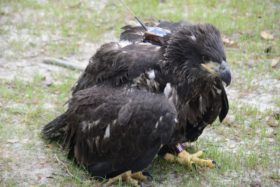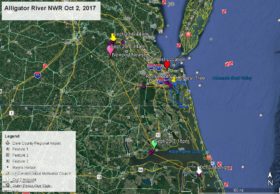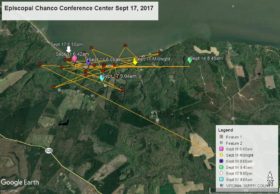Bald Eagle Egg Size and Color
Azalea flies south to Mattamuskeet NWR
February 3, 2010Azalea Remains at Mattamuskeet NWR Feb 5
February 5, 2010


Two questions that are frequently asked are what size are eagle eggs, and what color are they? The photos above compare two bald eagle eggs that came out of the Norfolk Botanical Garden nest in 2008 to a tennis ball and a baseball. The shape of the egg is called oval. The two eggs with the tennis ball and baseball measured 74mm X 56mm. One weighed 126 grams (4.5oz) and the other 122 grams (4.3oz). The color is matte white. However it is normal for bald eagle eggs to become discolored during incubation. When nest material like pine straw gets wet it can stain the egg shells. You can see that with the two eggs beside the tennis ball and baseball.
The two bald eagle eggs in the nest in the middle photo above are the eggs in the nest now. The egg in front that is very white is the second egg that was laid yesterday Feb 3. The egg in back which is the first egg laid on Jan 31 is already slightly discolored. This is likely because the pine straw in the nest has been very wet from all the snow and rain, and because it was slightly less white when it was laid. There is also a piece of eagle down stuck on that egg from one of the adults.




5 Comments
The two eggs that were taken from the nest in 2008, shown in the pictures above, was anything learned from them that was previously unknown. Were the eaglets already formed and could they tell what sex they would have been? Did you get to do any of the research on these eggs?
Thanks,
Margy
Margy – Yes, the eggs were tested. They were only a few days old so the embroy had not formed. They were tested for chemicals and found to be within what is considered normal.
Reese, How far does the white tail extend up the eagles’s back? Why don’t we see more white of the tail on the back when in flight. I thought they had a short white tail and black wings and body. Looking at her in the nest, it appears different.
Hi Reese,
Why were the two eggs taken from the 2008 nest?
Thank you.
such good information reese. thanks so much. keep up the good work.